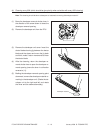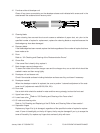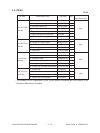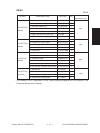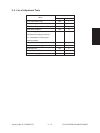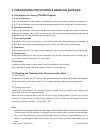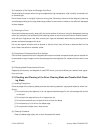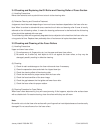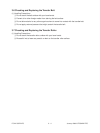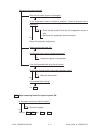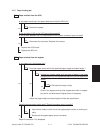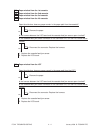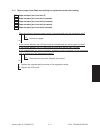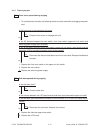
January 2000 © TOSHIBA TEC 3 - 3 FC-22 SUPPLIES
3.4 Checking and Replacing the Oil Roller and Cleaning Roller of Fuser Section
(1) Handling Precautions
Never allow solvents such as paint thinner to touch to the cleaning roller.
(2) Defective Cleaning and Corrective Treatment
Judgement should be made depending on how much toner has been deposited on the fuser roller sur-
face. When its surface is stained with toner, examine the oil roller and cleaning roller. If toner is heavily
adhered on the oil/cleaning rollers, it means the cleaning performance is declined and the oil/cleaning
rollers should be replaced with new ones.
The oil/cleaning rollers will be gradually degraded due to subjection to the heat from the fuser roller over
a long period of time. Replace them preferably after a fixed amount of copies have been made.
3.5 Checking and Cleaning of the Fuser Rollers
(1) Handling Precautions
Upper and lower fuser rollers
ᕃ Do not leave any oil (fingerprints, etc.) on the upper and lower fuser rollers.
ᕄ Be careful not to allow any hard object to hit or rub against the fuser rollers, or they may be
damaged, possibly resulting in defective cleaning.
(2) Checking
ᕃ Check for stain and damage on the fuser rollers and clean if necessary.
ᕄ Clean the separation claws and check for chipped claw tips.
ᕅ Check the cleaning effect of the cleaning roller.
ᕆ Check the thermistor for proper contact with the fuser roller.
ᕇ Check the fused condition of the toner image.
ᕈ Check the gap between the inlet guide and lower fuser roller.
ᕉ Check the fuser rollers for proper rotation.
(3) Cleaning Procedure for Fuser Rollers
When fuser rollers become dirty, they will cause jamming. If this happens, wipe the roller surface clean
with a suitable cloth. For easier cleaning, clean the rollers while they are still warm.
Note:
Be careful not to rub the fuser roller surface with your fingernails or hard objects because it can be easily
damaged. Do not use silicone oil on the fuser rollers.



